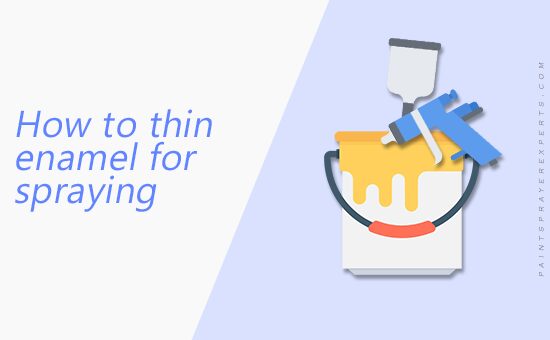Enamel paints are known for their unique thickness. Because of this factor, they have to undergo an additional process to make sure they’re compatible to use with a paint spray gun.
This process is known as thinning.
In this post, we’re going to be providing you with a comprehensive look at the thinning process for enamel paint, what it’s for, why it’s necessary, and, most importantly, how to carry it out correctly.

What is Enamel paint
Enamel paint is an oil-based paint that air-dries to a hard, glossy, glass-like finish. Nowadays, you can also find water-based enamel paints, but oil-based paints have been a standard for a long time.
Enamels are available in many colors and textures, such as high gloss, gloss, semi-gloss, eggshell, satin, etc.
Enamel paint uses
Enamel paints are highly versatile and can be used for numerous projects and surfaces where a glossy finish or a durable coating is preferred over other types of paint.
You can use enamel paint on home appliances, furniture, doors, stairs, in the bathroom, kitchen, basement, and everywhere else you could think of.
Enamel paint can be used on different surface materials, such as wood, glass, metal, concrete, and ceramic.
Enamel paint benefits
Other than its plentiful of uses, enamel paint has many other pros, such as:
- Resistant to moisture and humidity
- Offers mildew resistance
- Resistant to temperature changes
- Resistant to corrosion and rust
- Allows for frequent washing
- Easy to apply
- Because of the longer dry time, gives a more uniform and smoother finish
Why thinning enamel paint is important
Enamel paint is on the thicker side of the paint spectrum. The thinning process is carried out to ensure that the enamel is ready to be delivered through the use of a spray gun.
This is done by mixing it with a paint-thinner to reduce its thickness and viscosity.
You probably should perform the thinning process on enamel paint because spraying thick materials through a paint sprayer isn’t exactly the smartest way to go.
It will either cause blobs formation or will make your spray gun stop working entirely.
How to thin enamel paint for spray gun

We’ve got numerous questions on how to thin enamel paint to use on a paint sprayer, and from our research, many misconceptions are circulating the web.
Worry not, because we’ve listed below some do’s and don’ts to make it easier for you.
What not to do
When it comes to thining enamel paint for spraying, knowing what not to do is almost as important as knowing what to do, so before we explain the step by step on how to thin correctly, here are a few points on what you should try to avoid when undergoing the thinning process.
1. Thinning too much
Yes, this can happen and will happen if you’re not careful. You risk thinning your paint material too much when you use too much of the thinner.
If you let this happen, the enamel paint becomes too runny. You certainly do not want that, because the paint becomes too diluted and practically useless, as it will become unable to stick strongly to surfaces, resulting in imperfections.
2. Using the wrong thinner
Generally, latex and acrylic paints are thinned with water, and enamel or oil-based paints are thinned with mineral spirits or turpentine.
Also, you should always confirm that the material you’re working with can be thinned, as some paints don’t need to be thinned at all.
What to do
- Step 1: Wear your safety equipment. Never start a painting project without taking proper safety measures, such as wearing safety goggles, a protective mask, and a pair of gloves.
- Step 2: Confirm the exact enamel paint you’re working with, whether it’s water-based or oil-based. Check for the recommended thinner and the suggested ratio.
- Step 3: Begin to stir and mix your paint thoroughly. Pour it into an empty bucket using a paint strainer to ensure there aren’t any lumps left at the bottom.
- Step 4: Begin the thinning process by mixing it with the paint thinner, based on the paint type you have. The ratio depends on the type of paint and the type of thinner you’re going to use. To avoid making a big mess, start with a 1/3 thinner to paint ratio.
- Step 5: Get a test surface, perhaps cardboard or any other disposable surface, and test your current paint to thinner ratio. If it sprays evenly and easily, your material is correctly thinned and you’re ready to go. If it doesn’t, you should increase the thinner ratio.
- Step 6: Continue thinning until you achieve a 1/2 thinner to paint ratio and go through the testing process again.
- Step 7: If you still don’t have the perfect ratio, you can keep going until you get to 2/3 thinner to paint ratio. You should probably NEVER go beyond a 2/3 ratio, as the paint material will probably be too thin, and you risk losing your paint and making it completely useless.
- Step 8: Once you have a perfect ratio and a smooth spray, you may spend some extra seconds perfecting your pattern on the test surface before proceeding to the main project.
Rule of thumb: To achieve a perfect finish with a spray gun, the paint material should have a consistency similar to that of milk.
There are many enamel paint thinners out there, but we suggest this one right here.
Conclusion
So there you have it. We showed you how to thin enamel paint for spray gun.
Your enamel is all thinned and ready to go. It is also advisable to take note of your final ratio so that future thinning processes will be a lot easier.
As mentioned many times on this guide, it all depends on the paint type you’re going to use. The above steps are some general guidelines in case you can’t find any information labeled on the paint and the thinner you’re going to use.
My two cents: Less is better. Start with a low ratio of thinner, so you can always increase it if needed. The other way around is not possible, unfortunately.

Pingback: Should i thin my enamel paint when spray painting metal doors - 2 Paintings
I have Dutchboy satin 100% acrylic enamel paint as stated on the label. How would I thin this paint for spraying?